目标检测(object detection)
一、 介绍
在图像分类任务中,我们假设图像中只有一个主要物体对象,我们只关注如何识别其类别。 然而,很多时候图像里有多个我们感兴趣的目标,我们不仅想知道它们的类别,还想得到它们在图像中的具体位置。 在计算机视觉里,我们将这类任务称为目标检测(object detection)或目标识别(object recognition)。
目标检测所关注的问题:
- 分类:图片某个区域属于哪个类别;
- 定位:目标出现在图像中的哪个位置;
- 大小:目标的大小;
边界框
目标检测中,使用矩形的边界框(bounding box)描述对象的空间位置。图像以左上角为坐标 (0, 0) 点,水平向右为x坐标,垂直向下为y坐标。
%matplotlib inline
import torch
from d2l import torch as d2l
d2l.set_figsize()
img = d2l.plt.imread('../img/catdog.jpg')
d2l.plt.imshow(img);
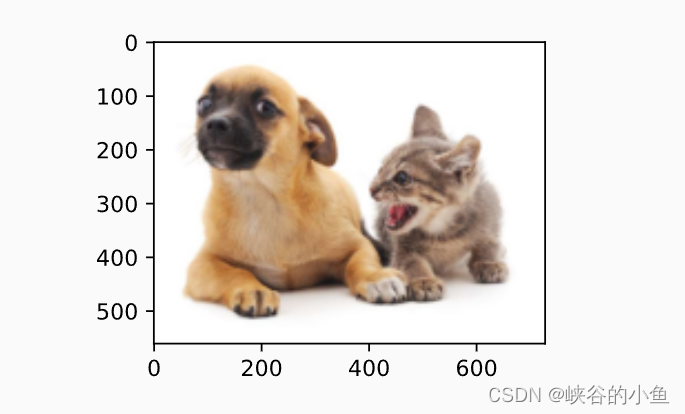
此时,边界框有两种表示方式:
- 使用边界框的左上角和右下角在图像中的坐标值来表示
- 或者使用矩阵的中心坐标和矩形的高和宽来表示
两种表示法之间可以相互转换:
# 边界框(bounding box): 描述对象的空间位置。
# 边界框是矩形的,有两种表示法:
# 1. 由左上角和右下角的x和y坐标决定,
# 2. 或中心位置x,y坐标和框的宽和高决定。
# 定义两种表示法之间转换的函数:
def box_corner_to_center(boxes):
"""
从(左上坐标,右下坐标)转换到(中心坐标,宽度, 高度)
Args:
boxes: tensor, 尺寸(batch_size, 4)
return:
boxes: tensor, 尺寸(batch_size, 4)
"""
x1, y1, x2, y2 = boxes[:, 0], boxes[:, 1], boxes[:, 2], boxes[:, 3]
# 中心坐标
cx = (x1 + x2) / 2
cy = (y1 + y2) / 2
# 宽度,高度
w = x2 - x1
h = y2 - y1
# torch.stack: 合并tensor序列,添加一个新维度
boxes = torch.stack((cx, cy, w, h), axis=-1)
return boxes
def box_center_to_corner(boxes):
"""
从(中心坐标,宽度, 高度)转换到(左上坐标,右下坐标)
Args:
boxes: tensor, 尺寸(batch_size, 4)
return:
boxes: tensor, 尺寸(batch_size, 4)
"""
cx, cy, w, h = boxes[:, 0], boxes[:, 1], boxes[:, 2], boxes[:, 3]
# 计算左上坐标
x1 = cx - 0.5 * w
y1 = cy - 0.5 * h
# 计算右下坐标
x2 = cx + 0.5 * w
y2 = cy + 0.5 * h
# 在维度1上合并
boxes = torch.stack((x1, y1, x2, y2), axis=-1)
return boxes
# 举例验证函数正确性
dog_bbox, cat_bbox = [60.0, 45.0, 378.0, 516.0], [400.0, 112.0, 655.0, 493.0]
boxes = torch.tensor((dog_bbox, cat_bbox))
box_center_to_corner(box_corner_to_center(boxes)) == boxes
输出
tensor([[True, True, True, True],
[True, True, True, True]])
在图像上添加边界框之后,检测对象的主要轮廓基本上在两个框内。
# 绘制边界框
def bbox_to_rect(bbox, color):
# bbox: sequence, 边界框(左上x, 左上y, 右下x, 右下y)
# color: 边框颜色,e.g. "blue", "red"
# plt.Rectangle 绘制长方形
return plt.Rectangle(
xy=(bbox[0], bbox[1]), # 锚点,即左上角坐标
width=bbox[2]-bbox[0], # 矩形的宽
height=bbox[3]-bbox[1], # 矩形的高
fill=False,
edgecolor=color,
linewidth=2
)
fig = plt.imshow(img)
fig.axes.add_patch(bbox_to_rect(dog_bbox, 'blue'))
fig.axes.add_patch(bbox_to_rect(cat_bbox, 'red'));
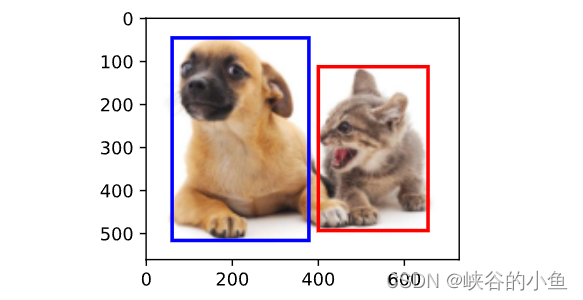
二、检测区域——锚框
目标检测算法,一般会先抽取候选区域。通常,在输入图像中先采样大量的区域,然后判断这些区域中是否包含要检测的目标,并调整候选区域的边界,从而更加准确的预测目标的真实边界。
这里介绍一种方法:锚框,以每个像素为中心,生成多个不同缩放比和宽高比的边界框。
生成多个锚框
假设输入图像的高度为
h
h
h,宽度为
w
w
w。
对图片的每个像素生成不同形状的锚框:缩放比
s
∈
(
0
,
1
]
s\in(0,1]
s∈(0,1],高宽比为
r
>
0
r>0
r>0。
则
s
=
w
a
h
a
w
h
s=\frac{w_ah_a}{wh}
s=whwaha、
r
=
w
a
h
a
r=\frac{w_a}{h_a}
r=hawa条件下锚框的宽度
w
a
w_a
wa和高度
h
a
h_a
ha分别为:
w
a
=
r
s
w
h
,
h
a
=
s
w
h
r
w_a=\sqrt{rswh}, h_a=\sqrt{\frac{swh}{r}}
wa=rswh,ha=rswh。
在下面代码中,因为将坐标缩放到了(0, 1)之间,并且最终返回的锚框的坐标也是(0,1)之间的值。因此,在代码中 宽和高的计算分别为:
w a s = r s h w w_{as}=\sqrt{\frac{rsh}{w}} was=wrsh, h a s = s w r h h_{as}=\sqrt{\frac{sw}{rh}} has=rhsw。
在绘制时,通过下式得到以像素为单位的宽和高:
w a = w ⋅ r s h w w_{a}=w\cdot\sqrt{\frac{rsh}{w}} wa=w⋅wrsh, h a = w ⋅ s w r h h_{a}=w\cdot\sqrt{\frac{sw}{rh}} ha=w⋅rhsw
# 生成多个锚框
# 假设输入图像:高 h, 宽 w
# 以图像的每个像素为中心生成不同形状的锚框:不同缩放比 (0,1], 高宽比 r > 0
# 锚框的宽度和高度分别为 sqrt(rswg), sqrt(swh/r)
# 设置缩放比取值[s1, s2,..., sn], 高宽比取值[r1, r2,..., rm], 则输入图像将有 whnm 个锚框
# 为降低复杂性,值旋转包含 s1 和 r1 的锚框, 则一个像素生成 n+m-1 个锚框,共 wh(n+m-1) 个
def multibox_prior(data, sizes, ratios):
"""
生成以像素为中心具有不同形状的锚框
Args:
data: 形状(批量大小,通道数,高,宽)
sizes: 1-D sequence, 缩放比
ratios: 1-D sequence,宽高比
"""
# 取图像的高和宽,存放设备,锚框大小列表长度,锚框宽高比列表长度
in_height, in_width = data.shape[-2:]
device, num_sizes, num_ratios = data.device, len(sizes), len(ratios)
# 大小列表和宽高比列表决定了每个像素生成的锚框数量
# 并将其转换为tensor
boxes_per_pixel = (num_sizes+num_ratios-1)
size_tensor = torch.tensor(sizes, device=device)
ratio_tensor = torch.tensor(ratios, device=device)
# 为了将锚点移动到像素的中心,需要设置偏移量
# 因为一个像素的的高为1且宽为1,我们选择偏移我们的中心0.5
offset_h, offset_w = 0.5, 0.5
# 高和宽按照自身长度的缩放比例
steps_h = 1.0 / in_height # 在y轴上缩放步长
steps_w = 1.0 / in_width # 在x轴上缩放步长
# 单个像素大小为 1*1
# 所以,将所有像素点的横/纵坐标+0.5(即加上上面设置的偏移量),得到每个像素的中心坐标
# 然后,乘以缩放比例,归一化到(0,1)之间
# 这就生成了锚框的所有中心点的横/纵坐标
center_h = (torch.arange(in_height, device=device) + offset_h) * steps_h
center_w = (torch.arange(in_width, device=device) + offset_w) * steps_w
# 生成中心点的横坐标tensor 和纵坐标 tensor
# shift_y,shift_x 的形状都是:(in_height, in_width)
shift_y, shift_x = torch.meshgrid(center_h, center_w)
# 将shift_y,shift_x展平为一维,形状变为:(in_height * in_width)
# 最终得到每个锚框中心点的横坐标 shift_x 和列坐标 shift_y
shift_y, shift_x = shift_y.reshape(-1), shift_x.reshape(-1)
# 生成“boxes_per_pixel”的每个锚框的高和宽,
# 之后用于创建锚框的四角坐标(xmin,xmax,ymin,ymax)
w = torch.cat((torch.sqrt(size_tensor * ratio_tensor[0]*in_height/in_width),
torch.sqrt(sizes[0] * ratio_tensor[1:])*in_height/in_width))
h = torch.cat((torch.sqrt(size_tensor * in_width / (ratio_tensor[0] * in_height)),
torch.sqrt(sizes[0] * in_width / (ratio_tensor[1:] * in_height))))
# 为每个中心点生成一组所有锚框的(-w, -h, w, h)
# 除以2来获得半高和半宽
# anchor_manipulations 的形状: (boxes_per_pixel * in_height * in_width, 4)
anchor_manipulations = torch.stack((-w, -h, w, h)).T.repeat(
in_height * in_width, 1) / 2
# 每个中心点都将有“boxes_per_pixel”个锚框,
# 将[shift_x, shift_y, shift_x, shift_y]的每个元素作为列,合并为二维tensor
# 并在 0 维上,按行,每行复制 boxes_per_pixel遍
# 最终,生成含所有锚框中心的网格,重复了“boxes_per_pixel”次
# out_grid 的形状: (boxes_per_pixel * in_height * in_width, 4)
out_grid = torch.stack([shift_x, shift_y, shift_x, shift_y],
dim=1).repeat_interleave(boxes_per_pixel, dim=0)
# 在中心坐标的基础上,加减半个宽或高,得到锚框的左上角坐标和右下角坐标
output = out_grid + anchor_manipulations
# 返回output,形状 (批量大小, 锚框数量, 4)
return output.unsqueeze(0)
测试定义的函数
d2l.set_figsize()
img = d2l.plt.imread('./img/catdog.jpg')
h, w = img.shape[:2]
print(h, w)
X = torch.rand(size=(1, 3, h, w))
Y = multibox_prior(X, sizes=[0.75, 0.5, 0.25], ratios=[1, 2, 0.5])
boxes = Y.reshape(h, w, 5, 4)
print(boxes[250, 250, :, :])
输出:
tensor([[-0.04, -0.05, 0.72, 0.94],
[ 0.03, 0.04, 0.65, 0.85],
[ 0.12, 0.16, 0.56, 0.73],
[-0.13, 0.10, 0.82, 0.80],
[ 0.11, -0.25, 0.58, 1.14]])
定义函数,绘制某一个像素为中心的全部锚框
def show_bboxes(axes, bboxes, labels=None, colors=None):
"""
显示以某个像素为中心的所有边界框
Args:
axes:
bboxes: 单个像素的所有锚框坐标的tensor
labels: 边界框标签列表
colors: 边界框颜色列表
"""
def _make_list(obj, default_values=None):
if obj is None:
obj = default_values
elif not isinstance(obj, (list, tuple)):
obj = [obj]
return obj
labels = _make_list(labels)
colors = _make_list(colors, ['b', 'g', 'r', 'm', 'c'])
for i, bbox in enumerate(bboxes):
# 画边界框
color = colors[i % len(colors)]
rect = bbox_to_rect(bbox.detach().numpy(), color)
axes.add_patch(rect)
# 添加边框的标签
if labels and len(labels) > i:
text_color = 'k' if color == 'w' else 'w'
axes.text(rect.xy[0], rect.xy[1], labels[i],
va='center', ha='center', fontsize=9, color=text_color,
bbox=dict(facecolor=color, lw=0))
# 测试函数:
set_figsize()
bbox_scale = torch.tensor((w, h, w, h))
fig = plt.imshow(img)
show_bboxes(fig.axes, boxes[250, 250, :, :] * bbox_scale,
['s=0.75, r=1', 's=0.5, r=1', 's=0.25, r=1', 's=0.75, r=2',
's=0.75, r=0.5'])
输出:

三、计算锚框和真实边框之间的相似性——交并比 IoU
- 如何量化锚框和真实边界之间的相似性?
杰卡德系数:jaccard,可以衡量两集合A,B之间的相似性,J(A,B) = (A∩B)/(A∪B)。
交并比 (IoU):将边界框看作为像素的集合,使用杰卡德系数来测量两个边界框的相似性,并将其称之为
交并比 (IoU): 两个边界框相交面积之比,取值范围在0和1之间。
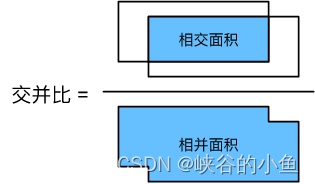
# 交并比
"""
1. 如何量化锚框和真实边界之间的相似性?
杰卡德系数:jaccard,可以衡量两集合A,B之间的相似性,J(A,B) = (A∩B)/(A∪B)。
边界框看作为像素的集合,使用杰卡德系数来测量两个边界框的相似性,并将其称之为
交并比 (IoU): 两个边界框相交面积之比,取值范围在0和1之间。
"""
def box_iou(boxes1, boxes2):
"""计算两个锚框或边界框列表中成对的交并比"""
# 计算锚框或边界框的面积
box_area = lambda boxes: ((boxes[:, 2] - boxes[:, 0])*
(boxes[:, 3] - boxes[:, 1]))
# boxes1, boxes2, areas1, areas2的形状
# boxes1: (boxes1的数量, 4)
# boxes2: (boxes2的数量, 4)
# areas1:(boxes1的数量,)
# areas2:(boxes2的数量,)
areas1 = box_area(boxes1)
areas2 = box_area(boxes2)
# inter_upperlefts,inter_lowerrights,inters的形状:
# (boxes1的数量,boxes2的数量,2)
# 如果两个框有交集,inter_upperlefts中对应的元素是重叠区域左上角坐标
# 如果两个框有交集,inter_lowerrights中对应的元素是重叠区域右下角坐标
# 此时,计算inter_lowerrights-inter_upperlefts时,坐标差为正
# 如果两个框无交集,则计算inter_lowerrights-inter_upperlefts时,坐标差为负
# torch.clamp(input, min, max):将tensor中的元素限制到一定范围内
# 这里使用torch.clamp将inter_lowerrights-inter_upperlefts的负值归零
# inters 的形状(boxes1的数量,boxes2的数量,2), 第三维是坐标差
inter_upperlefts = torch.max(boxes1[:, None, :2], boxes2[:, :2])
inter_lowerrights = torch.min(boxes1[:, None, 2:], boxes2[:, 2:])
inters = (inter_lowerrights - inter_upperlefts).clamp(min=0)
# 使用 inters 的坐标差计算相交的面积inter_areas,和相并的面积 union_areas
# inter_areas and union_areas的形状:(boxes1的数量,boxes2的数量)
inter_areas = inters[:, :, 0] * inters[:, :, 1]
union_areas = areas1[:, None] + areas2 - inter_areas
return inter_areas / union_areas
四、在训练数据中标注锚框
在训练集中:
将每个锚框视为一个训练样本,为训练目标检测模型,需要每个锚框的类别(class: 锚框相关的对象类别)和偏移量(offset: 真实边界框相对于锚框的偏移量)标签。
给定图像,假设锚框是
A
1
,
A
2
,
.
.
.
,
A
n
a
A_1,A_2,...,A_{na}
A1,A2,...,Ana,真实边界框是
B
1
,
B
2
,
.
.
.
,
B
n
b
B_1,B_2,...,B_{nb}
B1,B2,...,Bnb, 其中
n
a
>
=
n
b
n_a >= n_b
na>=nb。
定义一个矩阵
X
∈
R
n
a
×
n
b
X∈R^ {n_a×n_b}
X∈Rna×nb,其中第
i
i
i 行、第
j
j
j 列的元素
x
i
j
x_{ij}
xij 是锚框
A
i
A_i
Ai 和真实边界框
B
j
B_j
Bj 的IoU。
算法步骤:
- 在矩阵 X X X中找到最大的元素, 并将其的行索引和列索引分别表示为 i 1 i_1 i1和 j 1 j_1 j1。然后将真实边界框 B j 1 B_{j_1} Bj1分配给锚框 A i 1 A_{i_1} Ai1。因为 A i 1 A_{i_1} Ai1和 B j 1 B_{j_1} Bj1是所有锚框和真实边界框配对中最相近的。在第一个分配完成后,丢弃矩阵中行和列中的所有元素。
- 在矩阵 X X X中找到剩余元素中最大的元素,并将它的行索引和列索引分别表示为 i 2 i_2 i2和 j 2 j_2 j2。我们将真实边界框 A i 2 A_{i_2} Ai2分配给锚框 B i 2 B_{i_2} Bi2,并丢弃矩阵中行 i 2 t h i_{2th} i2th和列 j 2 t h j_{2th} j2th中的所有元素。
- 此时,矩阵中两行和两列中的元素已被丢弃。继续前序操作,直到丢弃掉矩阵 X X X中 n b n_b nb列中的所有元素。此时,已经为 n b n_b nb个锚框各自分配了一个真实边界框。
- 只遍历剩下的 n a − n b n_a-n_b na−nb个锚框。例如,给定任何锚框 A i A_i Ai,在矩阵 X X X的第 i t h i_{th} ith行中找到与 A i A_i Ai的IoU最大的真实边界框 B j B_j Bj,只有当此IoU大于预定义的阈值时,才将 B j B_j Bj分配给 A j A_j Aj。
# 算法实现:为锚框分别真实边界框标签
def assign_anchor_to_bbox(ground_truth, anchor, device, iou_threshold=0.5):
"""将最接近的真实边界框分配给锚框"""
num_anchors, num_gt_boxes = anchors.shape[0], ground_truth.shape[0]
# 位于第i行和第j列的元素x_ij是锚框i和真实边界框j的IoU
jaccard = box_iou(anchors, ground_truth)
# 对于每个锚框,分配的真实边界框的张量,首先初始化为-1,即背景值
anchors_bbox_map = torch.full((num_anchors,), -1, dtype=torch.long,
device=device)
# 根据阈值,决定是否分配真实边界框
# jaccard 每行的最大值,max_ious: 1-d tensor, 最大值,indices: 1-d tensor, 最大值下标(dim=1)
max_ious, indices = torch.max(jaccard, dim=1)
# anc_i: 1-D tensor, max_ious 中 IoU值大于0.5的值的下标,
# 也就是 jaccard 中IoU值大于0.5的值的 dim=0 的索引
anc_i = torch.nonzero(max_ious >= 0.5).reshape(-1)
# box_j: 1-D tensor, jaccard 中IoU值大于0.5的值的 dim=1 的索引
box_j = indices[max_ious >= 0.5]
# 给每个锚框赋予标签(即jaccard对应行中对打IoU对应的dim=1的索引值)
anchors_bbox_map[anc_i] = box_j
col_discard = torch.full((num_anchors,), -1)
row_discard = torch.full((num_gt_boxes,), -1)
for _ in range(num_gt_boxes):
# 计算jaccard中最大值的索引:anc_idx,box_idx
max_idx = torch.argmax(jaccard)
box_idx = (max_idx % num_gt_boxes).long()
anc_idx = (max_idx / num_gt_boxes).long()
# 给对应锚框赋予标签值
anchors_bbox_map[anc_idx] = box_idx
# jaccard中所在行和列的所有值置为-1
jaccard[:, box_idx] = col_discard
jaccard[anc_idx, :] = row_discard
# 返回 anchors_bbox_map: 1-D tensor, (num_anchors), 锚框的标签值。
return anchors_bbox_map
在为每个锚框分配了真实边界框,也就为锚框标记了分类类别,。之后,还需要对其标记与对应真实边界框之间的偏移。
标记偏移量
为每个锚框标记类别和偏移量,假设一个锚框A被分配给了一个真实边界框B。则锚框A的类别将被标记为与B相同,并且锚框A的偏移量将根据B和A中心坐标的相对位置以及这两个框的大小进行标记。直觉来说,可以直接使用锚框和真实边框之间的坐标差来标记偏移。但是这样的标记不利于学习。因此,将同时基于数据集内不同的框的位置和大小不同,应用变换来获得均匀拟合的偏移量。给定框A和B,中心坐标分别为
(
x
a
,
y
a
)
(x_a, y_a)
(xa,ya)和
(
x
b
,
y
b
)
(x_b,y_b)
(xb,yb),宽度分别为
ω
a
\omega_a
ωa和
ω
b
\omega_b
ωb,高度分别为
h
a
h_a
ha和
h
b
h_b
hb,则偏移量可以标记为:
(
x
b
−
x
a
w
a
−
μ
x
σ
x
,
y
b
−
y
a
h
a
−
μ
y
σ
y
,
l
o
g
w
b
w
a
−
μ
w
σ
w
,
l
o
g
h
b
h
a
−
μ
h
σ
h
)
(\frac{\frac{x_b-x_a}{w_a} - \mu_x}{\sigma_x}, \frac{\frac{y_b-y_a}{h_a} - \mu_y}{\sigma_y}, \frac{log \frac{w_b}{w_a} - \mu_w}{\sigma_w},\frac{log \frac{h_b}{h_a} - \mu_h}{\sigma_h})
(σxwaxb−xa−μx,σyhayb−ya−μy,σwlogwawb−μw,σhloghahb−μh)
其中常量的默认值为
μ
x
=
μ
y
=
μ
w
=
μ
h
=
0
\mu_x=\mu_y=\mu_w=\mu_h=0
μx=μy=μw=μh=0,
σ
x
=
σ
y
=
0.1
,
σ
w
=
σ
h
=
0.2
\sigma_x=\sigma_y=0.1, \sigma_w=\sigma_h=0.2
σx=σy=0.1,σw=σh=0.2。
# 偏移量计算
def offset_boxes(anchors, assigned_bb, eps=1e-6):
"""对锚框偏移量的转换"""
# 将锚框的表示方式转换为中心坐标加高宽的形式
c_anc = d2l.box_corner_to_center(anchors)
c_assigned_bb = d2l.box_corner_to_center(assigned_bb)
# 计算偏移量
offset_xy = 10 * (c_assigned_bb[:, :2] - c_anc[:, :2]) / c_anc[:, 2:]
offset_wh = 5 * torch.log(eps + c_assigned_bb[:, 2:] / c_anc[:, 2:])
offset = torch.cat([offset_xy, offset_wh], axis=1)
return offset
如果一个锚框没有被分配真实边界框,我们只需将锚框的类别标记为“背景”(background)。 背景类别的锚框通常被称为“负类”锚框,其余的被称为“正类”锚框。 我们使用真实边界框(labels参数)实现以下multibox_target函数,来标记锚框的类别和偏移量(anchors参数)。 此函数将背景类别的索引设置为零,然后将新类别的整数索引递增一。
#@save
def multibox_target(anchors, labels):
"""使用真实边界框标记锚框"""
# labels 形状 (batch_size, num_gt_boxes, 5)
# anchors 形状 (batch_size, num_anchors, 4)
batch_size, anchors = labels.shape[0], anchors.squeeze(0)
batch_offset, batch_mask, batch_class_labels = [], [], []
device, num_anchors = anchors.device, anchors.shape[0]
#
for i in range(batch_size):
# 为图片的锚框分配真实边界框
label = labels[i, :, :]
anchors_bbox_map = assign_anchor_to_bbox(
label[:, 1:], anchors, device)
# 将负类锚框的掩码置为0,bbox_mask 形状 (num_anchors, 4)
bbox_mask = ((anchors_bbox_map >= 0).float().unsqueeze(-1)).repeat(
1, 4)
# 将类标签和分配的边界框坐标初始化为零
class_labels = torch.zeros(num_anchors, dtype=torch.long,
device=device)
assigned_bb = torch.zeros((num_anchors, 4), dtype=torch.float32,
device=device)
# 使用真实边界框来标记锚框的类别。
# 如果一个锚框没有被分配,我们标记其为背景(值为零)
indices_true = torch.nonzero(anchors_bbox_map >= 0)
bb_idx = anchors_bbox_map[indices_true]
class_labels[indices_true] = label[bb_idx, 0].long() + 1
assigned_bb[indices_true] = label[bb_idx, 1:]
# 偏移量转换
offset = offset_boxes(anchors, assigned_bb) * bbox_mask
batch_offset.append(offset.reshape(-1))
batch_mask.append(bbox_mask.reshape(-1))
batch_class_labels.append(class_labels)
bbox_offset = torch.stack(batch_offset)
bbox_mask = torch.stack(batch_mask)
class_labels = torch.stack(batch_class_labels)
return (bbox_offset, bbox_mask, class_labels)
测试:
定义一个图片即真实标签和锚框:
ground_truth = torch.tensor([[0, 0.1, 0.08, 0.52, 0.92],
[1, 0.55, 0.2, 0.9, 0.88]])
anchors = torch.tensor([[0, 0.1, 0.2, 0.3], [0.15, 0.2, 0.4, 0.4],
[0.63, 0.05, 0.88, 0.98], [0.66, 0.45, 0.8, 0.8],
[0.57, 0.3, 0.92, 0.9]])
fig = d2l.plt.imshow(img)
show_bboxes(fig.axes, ground_truth[:, 1:] * bbox_scale, ['dog', 'cat'], 'k')
show_bboxes(fig.axes, anchors * bbox_scale, ['0', '1', '2', '3', '4']);
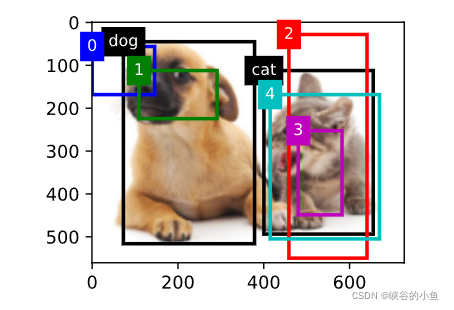
测试定义的multibox_target函数:
labels = multibox_target(anchors.unsqueeze(dim=0),
ground_truth.unsqueeze(dim=0))
for i in labels:
print(i)
输入:
tensor([[-0.00e+00, -0.00e+00, -0.00e+00, -0.00e+00, 1.40e+00, 1.00e+01,
2.59e+00, 7.18e+00, -1.20e+00, 2.69e-01, 1.68e+00, -1.57e+00,
-0.00e+00, -0.00e+00, -0.00e+00, -0.00e+00, -5.71e-01, -1.00e+00,
4.17e-06, 6.26e-01]])
tensor([[0., 0., 0., 0., 1., 1., 1., 1., 1., 1., 1., 1., 0., 0., 0., 0., 1., 1.,
1., 1.]])
tensor([[0, 1, 2, 0, 2]])
labels 中第一个元素是锚框标记的四个偏移量,形状 (batch_size, 4*num_anchors);第二个元素,掩码变量,size(批量大小, 4*num_anchors),掩码中的元素和锚框的四个偏移量一一对应,负类的偏移量不应影响目标函数,故对应掩码为0;第三个元素,预测的类别,形状(batch_size, num_anchors)。
五、非极大值抑制预测边界框
在预测时:为每个图像生成多个锚框,预测所有锚框的类别和偏移量,根据预测的偏移量调整它们的位置获得预测的边界框,最后,只输出符合特定条件的预测边界框。
预测时,先为图片生成多个锚框,然后经模型预测出带有预测偏移量的锚框,然后就可以进一步转化出预测的边界框。转化过程是上面介绍的偏移变换的逆过程。
def offset_inverse(anchors, offset_preds):
"""根据带有预测偏移量的锚框来预测边界框"""
anc = d2l.box_corner_to_center(anchors)
pred_bbox_xy = (offset_preds[:, :2] * anc[:, 2:] / 10) + anc[:, :2]
pred_bbox_wh = torch.exp(offset_preds[:, 2:] / 5) * anc[:, 2:]
pred_bbox = torch.cat((pred_bbox_xy, pred_bbox_wh), axis=1)
predicted_bbox = d2l.box_center_to_corner(pred_bbox)
return predicted_bbox
当有许多锚框时,可能会输出许多相似的具有明显重叠的预测边界框,都围绕着同一目标。为了简化输出,使用极大值抑制 (non-maximum suppression, NMS)合并属于同一目标的类似的预测边界框。
非极大值抑制:对于一个预测边界框B,目标检测模型会计算每个类别的预测概率。假设最大的预测概率为p,则该概率所对应的类别B即为预测的类别。具体来说,我们将p作为预测边界框B的置信度(confidence)。在所有预测的非背景边界框都按照置信度降序排列,生成列表L。然后通过以下步骤操作列表L:
- 从L中选取置信度最高的预测边界框 B 1 B_1 B1作为基准,然后将所有与 B 1 B_1 B1的IoU超过预定阈值 ϵ \epsilon ϵ的非基准预测边界框从L中移除。这时,L保留了置信度最高的预测边界框,去除了与其太过相似的其它预测边界框。简而言之,这些具有非极大值置信度的边界框被抑制了。
- 从L中选取置信度第二高的预测边界框 B 2 B_2 B2作为又一个基准,然后将所有与 B 2 B_2 B2的IoU大于 ϵ \epsilon ϵ的非基准预测边界框从L中移除。
- 重复上述过程,直到L中所有预测边界框都曾被作为基准。此时,L中任意一对预测边界框的IoU都小于阈值 ϵ \epsilon ϵ,不会过于相似。
- 输出列表L中的所有预测边界框。
def nms(boxes, scores, iou_threshold):
"""对预测边界框的置信度进行排序"""
B = torch.argsort(scores, dim=-1, descending=True)
keep = [] # 保留预测边界框的指标
while B.numel() > 0:
i = B[0]
keep.append(i)
if B.numel() == 1: break
iou = box_iou(boxes[i, :].reshape(-1, 4),
boxes[B[1:], :].reshape(-1, 4)).reshape(-1)
inds = torch.nonzero(iou <= iou_threshold).reshape(-1)
B = B[inds + 1]
return torch.tensor(keep, device=boxes.device)
# 定义以下multibox_detection函数来将非极大值抑制应用于预测边界框。
#@save
#@save
def multibox_detection(cls_probs, offset_preds, anchors, nms_threshold=0.5,
pos_threshold=0.009999999):
"""使用非极大值抑制来预测边界框"""
device, batch_size = cls_probs.device, cls_probs.shape[0]
anchors = anchors.squeeze(0)
num_classes, num_anchors = cls_probs.shape[1], cls_probs.shape[2]
out = []
for i in range(batch_size):
cls_prob, offset_pred = cls_probs[i], offset_preds[i].reshape(-1, 4)
conf, class_id = torch.max(cls_prob[1:], 0)
predicted_bb = offset_inverse(anchors, offset_pred)
keep = nms(predicted_bb, conf, nms_threshold)
# 找到所有的non_keep索引,并将类设置为背景
all_idx = torch.arange(num_anchors, dtype=torch.long, device=device)
combined = torch.cat((keep, all_idx))
uniques, counts = combined.unique(return_counts=True)
non_keep = uniques[counts == 1]
all_id_sorted = torch.cat((keep, non_keep))
class_id[non_keep] = -1
class_id = class_id[all_id_sorted]
conf, predicted_bb = conf[all_id_sorted], predicted_bb[all_id_sorted]
# pos_threshold是一个用于非背景预测的阈值
below_min_idx = (conf < pos_threshold)
class_id[below_min_idx] = -1
conf[below_min_idx] = 1 - conf[below_min_idx]
pred_info = torch.cat((class_id.unsqueeze(1),
conf.unsqueeze(1),
predicted_bb), dim=1)
out.append(pred_info)
return torch.stack(out)
举例:
anchors = torch.tensor([[0.1, 0.08, 0.52, 0.92], [0.08, 0.2, 0.56, 0.95],
[0.15, 0.3, 0.62, 0.91], [0.55, 0.2, 0.9, 0.88]])
offset_preds = torch.tensor([0] * anchors.numel())
cls_probs = torch.tensor([[0] * 4, # 背景的预测概率
[0.9, 0.8, 0.7, 0.1], # 狗的预测概率
[0.1, 0.2, 0.3, 0.9]]) # 猫的预测概率
# 未使用非极大值抑制
fig = plt.imshow(img)
show_bboxes(fig.axes, anchors * bbox_scale,
['dog=0.9', 'dog=0.8', 'dog=0.7', 'cat=0.9'])
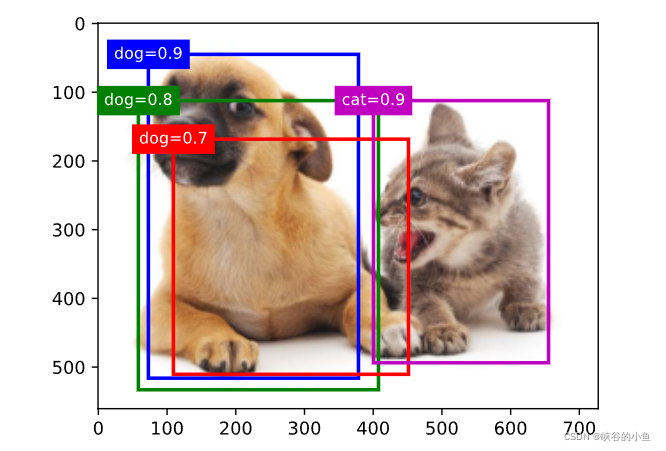
可以调用multibox_detection函数来执行非极大值抑制,其中阈值设置为0.5。
output = multibox_detection(cls_probs.unsqueeze(dim=0),
offset_preds.unsqueeze(dim=0),
anchors.unsqueeze(dim=0),
nms_threshold=0.5)
fig = plt.imshow(img)
for i in output[0].detach().numpy():
if i[0] == -1:
continue
label = ('dog=', 'cat=')[int(i[0])] + str(i[1])
show_bboxes(fig.axes, [torch.tensor(i[2:]) * bbox_scale], label)

参考:动手学深度学习






















 838
838











 被折叠的 条评论
为什么被折叠?
被折叠的 条评论
为什么被折叠?








